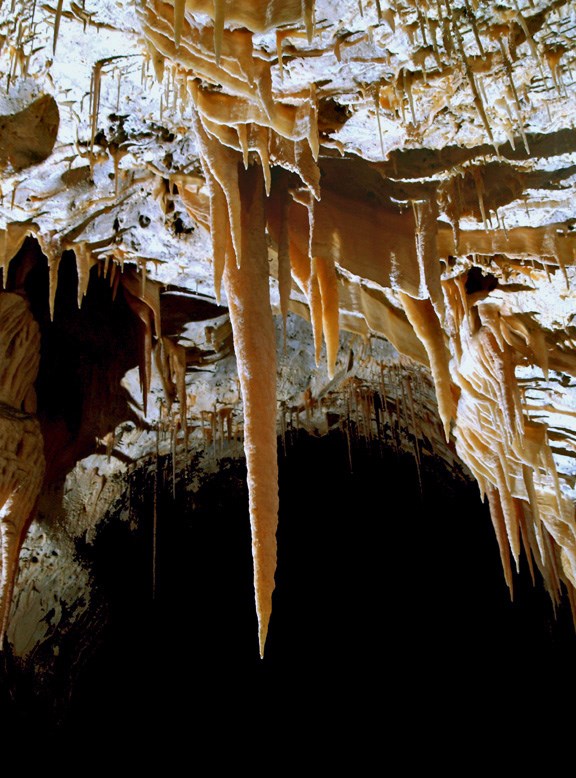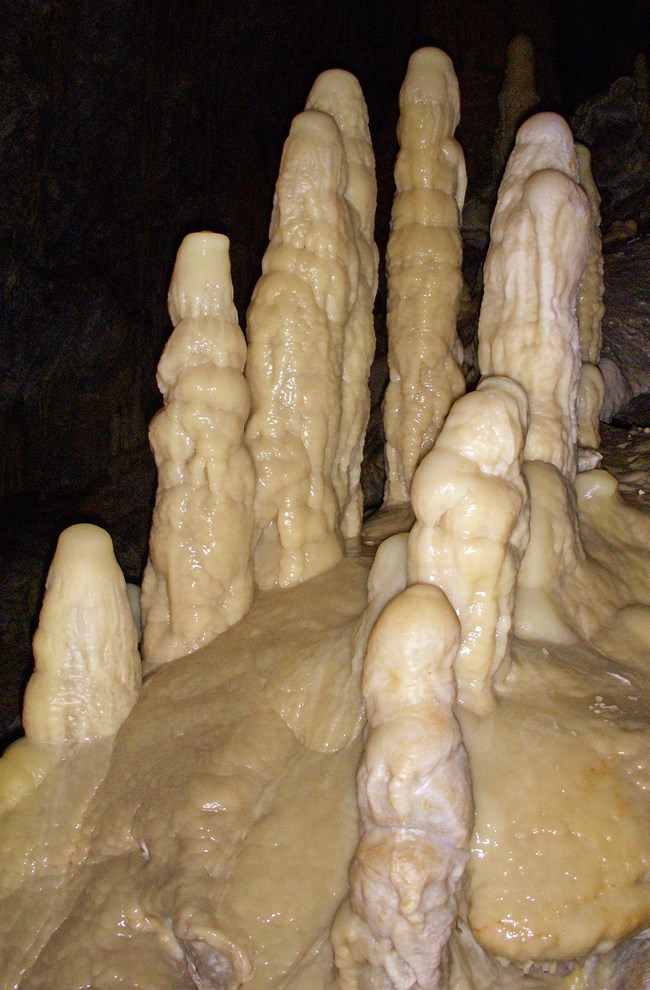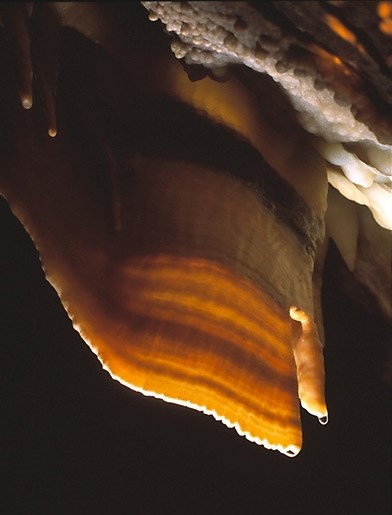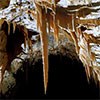
NPS Photo.
Introduction
The features that arouse the greatest curiosity for most cave visitors are speleothems. These stone formations exhibit bizarre patterns and other-worldly forms, which give some caves a wonderland appearance. Caves vary widely in their displays of speleothems because of differences in temperature; overall wetness; and jointing, impurities, and structures in the rocks. In general, however, one thing caves do have in common is where speleothems form. Although the formation of caves typically takes place below the water table in the zone of saturation, the deposition of speleothems is not possible until caves are above the water table in the zone of aeration. As soon as the chamber is filled with air, the stage is set for the decoration phase of cave building to begin.
The term speleothem refers to the mode of occurrence of a mineral—i.e., its morphology or how it looks—in a cave, not its composition (Hill, 1997). For example, calcite, the most common cave mineral, is not a speleothem, but a calcite stalactite is a speleothem. A stalactite may be made of other minerals, such as halite or gypsum.
Classifying speleothems is tricky because no two speleothems are exactly alike. Nevertheless, speleologists have taken three basic approaches: classification by morphology, classification by origin, and classification by crystallography. All three of these approaches have their problems (Hill, 1997), so cavers often take a more practical approach that primarily uses morphology (e.g., cave pearls) but includes whatever is known about origin (e.g., geysermites) and crystallography (e.g., spar) when needed.
Cave Minerals of the World (Hill, 1997) refers to 38 different types of speleothems and numerous subtypes and varieties.
Dripstone

NPS photo by Dale Pate.

NPS photo by Ronal C. Kerbo.
Stalactites
Stalactites are the most common and most familiar of all speleothems; they resemble icicles or carrots hanging from cave ceilings. Stalactites range in size from small, slender, soda straws to thick, massive pendants tens of feet long and wide.
Stalactites are usually composed of calcite, but they may consist of other minerals. All stalactites, whatever their composition, begin their growth as hollow soda straws. At first a water droplet collects on the cave ceiling by condensation or by water coming through a fracture in the rock. With the loss of carbon dioxide, a thin film of carbonate material precipitates and covers the surface of the drop. Similarly with evaporation in arid cave environments, a thin film of sulfate or other noncarbonate material precipitates over the surface of the drop. As the drop accumulates more water and becomes heavier, it begins to oscillate. This causes the film of material to move up toward the ceiling and to adhere there by surface tension. When the drop falls to the floor, this film is left on the ceiling as a round rim of material—the initial growth ring of a soda straw (Hill, 1997). As drop after drop follows a similar path, an infinitesimal trace of material is left behind, and a hollow tube is created and eventually enlarged, as long as water continues to drip. It is not surprising, then, that the word stalactite is Greek for “oozing out in drops.”
Helictites
Helictites are contorted speleothems that twist in any direction, seemingly in defiance of gravity. The term “helictite” comes from the Greek root helix, meaning to spiral. Helictites have been compared to “the horrible, snaky tresses of Medusa” (Hill, 1997). They have been described as threads, beads, worms, and antlers or twigs.
Helictites grow on cave ceilings, walls, and less often on cave floors. They typically grow on other speleothems, such as carbonate coatings, crusts, and sometimes on soda straws.
Regardless of size or shape, all helictites have one thing in common: they possess tiny central channels through which their extremities and diameters are fed and increased by seeping capillary water.

NPS photo.

NPS photo by Dale Pate.
Stalagmites
Stalagmites are convex floor deposits built up by water dripping from an overhead stalactite or from the cave ceiling. Because falling water droplets tend to splash, stalagmites spread out as they gradually build up from the floor. Hence, they do not have central, hollow tubes like stalactites. Stalagmites are usually larger in diameter than the stalactites above them and they generally have rounded tops instead of pointed tips.
“That which drops” is the Greek meaning of stalagmites. When a drop of water falls from the ceiling or stalactite, it still has some material left in solution. When the drop hits the floor, carbon dioxide is given off and carbonate material is precipitated as a mound below the point of dripping; or, if a noncarbonate mineral, evaporation causes precipitation of mineral material.
Stalagmites can assume a fascinating variety of shapes and people have compared them to broomsticks, totem poles, toadstools, bathtubs, Christmas trees, beehives, coins and buttons, and even fried eggs!
Columns
Columns are not stalactites nor are they stalagmites; they are both, together. When a stalagmite grows together with its counterpart feeder stalactite, a new speleothem is formed: a column or pillar.
Columns can reach gigantic proportions, sometimes over 65 feet (20 m) in height and diameter. Typically the largest columns are aligned along ceiling joints, where the greatest amount of water is dripping into the cave.

NPS photo.
Flowstone

NPS photo by Dale Pate.
Flowstone is one of the most common speleothems. It has been described as “melted cake icing” and “frozen waterfalls.” Flowstone is usually composed of calcite or other carbonate minerals, and deposition is in layers or bands. Where composed of calcite, individual flowstone layers may be very colorful: yellows, reds, and oranges.
Flowstone differs from coatings in that it deposits from flowing water and not from seeping water, but in reality, these two speleothem types are intergraded (Hill, 1997).
Flowstone forms both in the open air and under water and assumes a variety of forms. The most common of these is the petrified or frozen waterfall, also referred to as cascades, rivers, glaciers, or organ pipes. A well know example of waterfall flowstone is Frozen Niagara in Mammoth Cave. In places, flowstone can form on sedimentary rock, which is later washed away, leaving the flowstone as a canopy. Flowstone also forms in running streams where carbon dioxide degasses as water tumbles over rocks in a stream bed.

NPS photo.
Draperies
When water drops flow down a sloped ceiling before dripping to the floor, calcite can build up in a line. These lines gradually form “draperies” or “cave bacon.” This type of speleothem is found in almost every cave in the world and is universally popular because of the close resemblance to its namesake (Nelson, 2000). Iron oxide or organic solutions form the baconlike stripes. As the formations grow, small undulations in the bedrock cause the draperies to become slightly curved. With time these curves become more and more accentuated so that the draperies become highly folded or furled along their lower edges. Dripstones may form at the bottom of draperies where the furls are steep enough for water droplets to fall to the floor.
Cave Crystals

NPS photo by Marc Ohms.
Cave flowers
Caves are greenhouses for flowers formed of cave minerals, typically gypsum. The crystal petals of these speleothems radiate out from a common center. The formation grows from a base rather than a tip like stalactites. Variations in crystal structure produce unique, curved, flowerlike petals.
Cave flowers have been found in may caves throughout the world. Hovey (Hovey, 1896) must have been quite taken by the gypsum flowers when he saw them in Mammoth Cave in 1896 for he describes them in overtly flowery language:
From a central stem gracefully curl countless crystals, fibrous and pellucid; each tiny crystal is itself a study; each fascicle of curved prisms is wonderful; and the whole blossom is a miracle of beauty…. Floral clusters, bouquets, wreaths, garlands, embellish nearly every foot of the ceiling and walls…. Clumps of lilies, pale pansies, blanched tulips, drooping fuchsias, sprays of asters, spikes of tube-roses, wax-leaved magnolias—but why exhaust the botanical catalogue? The fancy finds every gem of the green-house and parterre in this crystalline conservatory.
A fantastic gypsum flower display has also been found in Lechuguilla Cave, Carlsbad Caverns National Park, New Mexico.
Frostwork
Frostwork is a needlelike speleothem resembling cactus or thistle plants. It is the acicular habit of aragonite that gives most frostwork its spiny appearance. However, frostwork can be composed of calcite, opal, gypsum, other minerals, and ice. It is usually white but can also be other colors, including blue (Hill, 1997).
Frostwork occurs worldwide in the caves of Australia, Brazil, Japan, Korea, Norway, Romania, South Africa, and the United States. The most common occurrence of frostwork is with coralloids, for example, clusters of needles frequently radiate from the tips of popcorn nodules. Frostwork can also be found on stalactites, walls, ceilings, ledges, and less occasionally on floors (Hill, 1997).
Frostwork displays can be dazzling! They are among the most exquisite, fragile, and intricate of all speleothem types. Unfortunately, their beauty makes them prime targets for vandalism, and their delicate nature makes them easily destroyed by carelessness.

NPS photo.
Moonmilk
Moonmilk forms very fine crystals that vary in composition. Moonmilk’s fine-grained particles become suspended in water, which gives the deposit the appearance of milk. Moonmilk is soft and pasty when wet, but crumbly and powdery when dry. Wet moonmilk looks and feels like cream cheese; dry moonmilk resembles talcum powder. For centuries, moonmilk has been used for medicinal purposes: a poultice to stop bleeding, for fevers, for diarrhea, and as an antacid.

NPS photo.
Other Cave Formations
Coralloids
Coralloid (or corallite or cave popcorn) is a catchall term describing knobby, nodular, botryoidal, or corallike speleothems. After stalactites, stalagmites, and flowstone, coralloids are probably the most common speleothem type (Hill, 1997). Coralloids range in size from tiny beads to globular masses a few feet in diameter. Coralloids include cave popcorn, grapes, knobstone, coral, cauliflower, globularites, and grapefruit. Coralloids can form both in the open air and under water.

NPS photo.
Cave pearls
Cave pearls are concentrically banded concretions that form in shallow cave pools. Cave pearls vary in shape; they can be spherical, cylindrical, irregular, cubical, or even hexagonal. They can range in size from smaller than a sand grain up to eight inches (20 cm) in diameter. Cave pearls have been compared to marbles, hailstones, cupcakes, cigars, oranges, pigeon’s eggs, balls, and most of all, pearls from whence their name comes. The luster of cave pearls justified their naming back in 1874, but they can also be rather dull.
Cave pearls are known to occur in numerous caves, but exceptional displays exist in caves in the Guadalupe Mountains, New Mexico. In 1929, Hess described the fabulous cave pearls in the Rookery of Carlsbad Cavern (Hess, 1929), which were once so numerous that specimens were handed out as souvenirs in the early days of commercialism (Hill, 1997).
Cave pearls normally grow in shallow cave pools where water is dripping in from above or slowing flowing into the pool. Carbon dioxide is lost to the air, carbonate material precipitates around clastic particles in the pool, and excess precipitate material coats the floor and builds up into cups or nests around the pearls. Sand grains, bat bones, shell and wood fragments, or pieces of soda straws may act as nuclei for cave-pearl growth; all of these fragments become rounded as they grow into cave pearls of different shapes (Hill, 1997).
Dripping water can agitate cave pearls, but it does not rotate them, round them, or polish them. Instead, cave pearls become round because the growing speed of the outer layer of the pearl is the same in all directions due to the water in the pearl nest being supersaturated. A spherical shape is the structure that allows for the greatest amount of material for the smallest surface area; therefore, a round shape is naturally promoted even for pearls with highly irregular nuclei (Hill, 1997).

Speleogens

NPS photo.
Speleogens are the result primarily of erosive forces on the bedrock. Box work is a good example of how minerals infill fractures and then the limestone is eroded away.
Boxwork
Boxwork is so named because it resembles a maze of post office boxes. Intricate networks of fins or plates protrude in relief from bedrock walls, ceilings, speleothems, or floors. Boxwork can be composed of any mineral more resistant than its surrounding medium, but calcite is most common.
The best exposure of calcite boxwork are in the caves of the Black Hills, South Dakota, most remarkably in Wind Cave, a national park, where blades of crystalline material protrude outward from cave walls and ceilings for 24 inches (60 cm) or more (Hill, 1997).
Featured Learning Activity

Related Links
Last updated: April 27, 2022
